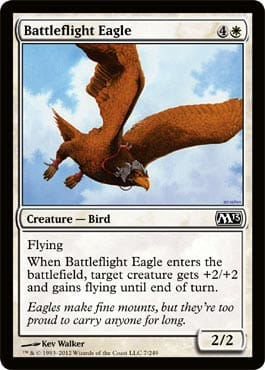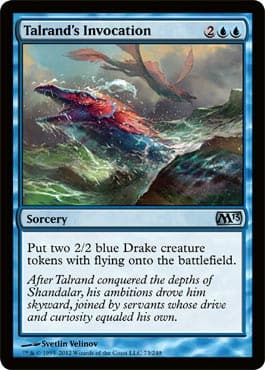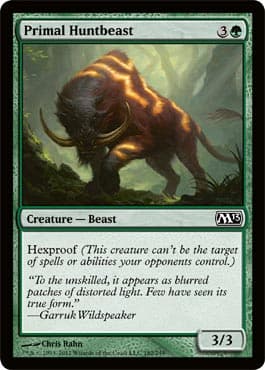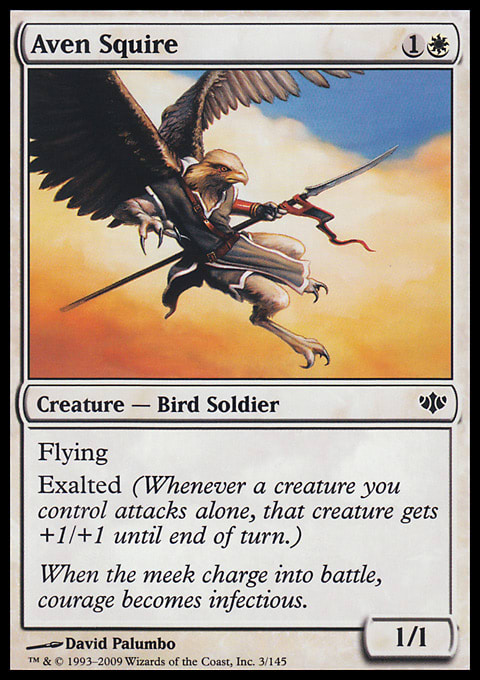After finishing 7–3 on Day 1 of Grand Prix: Boston, I needed to go 6–0 to have any impact on the final standings, and the Top 8 was almost certainly out of reach. Of course, that didn’t mean that it wasn’t a good opportunity for learning. Any time you can make Day 2 of a premier event should be viewed as a golden opportunity to hone your craft against high-level competition. I feel that my game plan for the first Draft was okay, but the result was pretty much a disaster:
"Draft 1"
- Creatures (20)
- 1 Ajani's Sunstriker
- 1 Crusader of Odric
- 1 Guardians of Akrasa
- 1 Healer of the Pride
- 1 Silvercoat Lion
- 1 Spiked Baloth
- 2 Aven Squire
- 2 Primal Huntbeast
- 2 War Falcon
- 3 War Priest of Thune
- 5 Battleflight Eagle
- Spells (3)
- 1 Pacifism
- 2 Divine Favor
- Lands (17)
- 10 Plains
- 6 Forest
- 1 Sunpetal Grove
I hadn’t played with Battleflight Eagle very much, but it has been enough to know that running five of them was probably a bad sign. Don’t get me wrong: I tried to make the best of them by designing my deck with them in mind—Primal Huntbeast, Spiked Baloth, Crusader of Odric, and Ajani's Sunstriker all love to fly and cost less than 5, but still . . .
I had zero instants and sorceries. In case you’re not sure, this is a much worse sign than the five Eagles. When I’m drafting, I usually like to pick one color to read and one to write. Put another way, I cut one color off while waiting to see what other color is being fed to me. In this instance, the color I cut also happened to be the color being fed to me: white. This left me without an obvious second color to draft. In the end, I had enough playables to go mono-white. I could go with three to four green cards or I could run three to four black cards. While mono-white was tempting, my Eagles would have been too lame in that build. The combination of the Sunpetal Grove and the fat, green 4-drops convinced me to go with the build I chose.
While I went 1 2 with it, I did have a pretty memorable match. I was playing against a U/B control deck with multiple Talrand's Invocation, Talrand, Sky Summoner, and multiple Mind Rot. Suffice it to say, it was a much better deck than mine. He cast two Mind Rots in Game 1 and made me discard two spells both times. This was after I had already mulliganed to six, so it was game over.
Game 2 was the crazy one. If I told you he cast Talrand's Invocation four times and I cast Battleflight Eagle four times, I doubt you’d be picking me as the winner. The problem for him was I kept giving a Primal Huntbeast +2/+2 and sending it to the air. As I mentioned to him when I cast the second one, “I call this the Battleflight Eagle portion of the game.” He never left more than two Drake tokens back on defense (in part because, Who plays five Eagles?), and thus, every time, he was faced with the unenviable choose of taking 5 damage or chump-blocking. At the same time, I gained a flyer to trade with a Drake each time.
The game had gone off to a lousy start for me, too. I wanted to play a turn-one War Falcon so I could play a turn-two Aven Squire and hit for 3 immediately, but my only source of white was my Grove, which I played tapped. I played turn-two Squire and turn three Crusader, but he killed both with a Cower in Fear. This left me with a Falcon but without the two creatures that would allow it to attack. To make matters worse, I proceeded to draw my other Falcon. I ended up trading both of them for Drake tokens. He cast one Invocation on turn four, brought it back with Archaeomancer, Unsummoned the Archaeomancer, and returned the Invocation again . . . and then he just drew another Invocation.
Since I knew about the Mind Rots and my decks lacked reactive cards anyway, much of the skill was removed from the game. I felt like such a newb. I played every card as I drew it without holding any cards in my hand, not even for bluffing value. Even my attacking and blocking decisions were pretty straightforward. I very quickly came to the realization that I would probably lose the game, so I planned accordingly. I decided to play a game that would allow me to win if I drew the right cards in more or less the right order. While this isn’t a strategy I generally recommend, sometimes you aren’t left with many other options. In this case, it happened to work out. On the last turn of the game, I drew a Glorious Charge that I had boarded in. He was at 3 life, and I attacked with my Huntbeast and my remaining Eagle. He chose to double-block the Beast and let the Eagle through. I cast the more-glorious-than-usual Charge for the win, and he looked at the fistful of cards still in his hand and the zero cards in my hand and said, “I’m not really sure how I lost that game.”
Unfortunately, my glory was short lived. In Game 3, I kept a one-land hand on the draw with three 2-drops and my Pacifism. I didn’t draw a second land the entire game, and I was suddenly 0–2 with the deck.
Over the course of the day, I consulted several other pros to solicit their views on Magic 2013 Draft. While nothing earthshattering, the most useful advice probably came from Jackie Lee. She pointed out that in past core-set Drafts, it often seemed that just drafting a deck with the forty most powerful cards you could assemble in one or two colors was the way to go. In this case, she felt drafting a specific archetype with tight, powerful synergies between the cards in the deck was critical to success. Some examples she gave were W/B with a ton of exalted and G/U with Primal Huntbeasts and Tricks of the Trade.
I discussed this with Paul “Little Darwin” Rietzl, and he disagreed with Jackie, although with the disclaimer that she was probably right due to his inexperience with the format. In practice, he actually seemed to agree. He showed me one of his Draft decks later. It was a G/U deck that actually had more instants and sorceries than creatures. He was running two Archaeomancers, two Talrand, two Augur of Bolas, and a Roaring Primadox as most of his creatures. The majority of the cards in his deck were pretty lame in a vacuum, but played together, his deck had the potential to be pretty nuts. To give you an idea how committed he was to Jackie’s approach over his own stated philosophy with this deck, he had a Wind Drake in his sideboard. As Paul put it, “Who pays mana for a 2/2 flyer?”
These lessons further hit home as I watched a side Team Draft between my first and second Drafts. I saw Andrew Cuneo play a U/R deck full of high-powered cards lose to a tight U/B control deck. Then, Billy Jensen replaced Andrew and proceeded to smash the U/B deck thanks to having three Primal Huntbeasts and three Mark of the Vampire in his deck.
Sidebar
For those of you who haven’t met Billy in person, he’s a bit of a giant (albeit a gentle one.) I’m 6’4”, 280 pounds, and Billy makes me feel like I’m tiny. Running into Billy and realizing this led to a feel-good moment at the GP. I was among the few Hall of Fame voters who didn’t vote for Billy this season. I felt his stats were only borderline given his competition and that he needed something else to put him over the top. In my case, he had no shot of making it over that fence. When he and I were at the height of our Pro Tour careers, we both lived in Massachusetts, and he often worked with my team, Team Your Move Games. On more than one occasion, he did things that I felt were unbecoming of a Magic pro and a teammate. In particular, I felt he was too willing to side with other young players who enjoyed saying cruel things about me. So he was going to need stronger stats to win my vote. As we chatted pleasantly at the GP and I started to wonder how he could possibly have become so big, I started to realize something.
Billy was a man-child when we met. I mentioned to Billy how much bigger he seemed, and he reminded me,” I was fourteen when we met Darwin, with the body of a twenty year old and the maturity of a twelve year old.” Since Billy was so big and so good at Magic when we met, it was easy to forget just how gosh-darn young he was. To his great credit, Billy has clearly changed. He and I are Facebook friends, and not only has he watched as I’ve declined to vote for him for two years, he’s even seen me discussing it with some of his true believers on Facebook. Despite knowing I won’t vote for him, he’s consistently been nice to me for over a year now and to an extent that I’m convinced it’s not just about a single Hall of Fame vote. After watching him dispatch his U/B opponent, we had another pleasant chat, and he pointed out (not for the first time) that he regretted succumbing to peer pressure when he was a teenager (something most people have done to some degree or another). I looked at Billy and informed him, “I respect your ability to be nice to me without expecting anything in return. I realize now just how young you were when you did the things that bother me, and I can see how much you’ve changed. I don’t guarantee you my vote next time, but I will assure you our past history won’t prevent me from voting for you.” This led to a hearty handshake, and speaking just for me, quite a bit of good feeling. That moment alone probably made it worth playing in an eighteen-hundred-person event for $40 and a weekend of my time.
I had never drafted B/G in Magic 2013, in part due to a preference for friendly colors in the set, but perhaps inspired by Billy’s example, I ended up in B/G in my second Draft:
"Draft 2"
- Creatures (16)
- 1 Acidic Slime
- 1 Bloodhunter Bat
- 1 Bond Beetle
- 1 Giant Scorpion
- 1 Knight of Infamy
- 1 Liliana's Shade
- 1 Sentinel Spider
- 1 Silklash Spider
- 1 Vampire Nighthawk
- 1 Yeva's Forcemage
- 2 Centaur Courser
- 2 Ravenous Rats
- 2 Roaring Primadox
- Spells (7)
- 1 Public Execution
- 1 Titanic Growth
- 1 Essence Drain
- 1 Prey Upon
- 2 Sign in Blood
- 1 Rancor
Much like my first Draft, I tried to write one color and read another. My first four picks were Vampire Nighthawk, Knight of Infamy, Public Execution, and Sign in Blood—in that order. So, I was cutting black as hard as possible. I used my fifth pick on an Aven Squire, thinking perhaps I’d end up with a W/B exalted deck. I picked up a Prey Upon with my sixth pick, and it quickly became clear I was in a better seat for green than for white. I picked an early Primadox in pack two and started picking 187 creatures higher. This paid off big time when I saw another Primadox in pack three. Suddenly, I had a deck with two Roaring Primadox and eight creatures that I was happy returning to my hand. I had good mana, a good curve, card-draw, removal, and several cards that were essentially bombs in my deck: the Primadoxes, Nighthawk, Rancor, Silklash Spider, and sometimes even the Shade.
This Draft went much better, as I ran the table without losing a game. To be fair, I drew my Primadoxes frequently, and some of my opponents seemed low on morale since we all knew we weren’t going to make the Top 64. One opponent asked me to concede to him because the Planeswalker Points mattered more to him since I’m in the Hall of Fame. I had never met him, and I explained to him that he was free to claim those points by defeating me if he was able. I certainly hadn’t spent two days playing Magic to start conceding matches to complete strangers.
While I’m always sad to be sidelined during the Top 8 of an event, it was nice to end my weekend on a high note with four straight wins—even if they didn’t even put me into the money. More importantly, I learned some valuable lessons about Magic 2013 Limited. This is just further proof that good players can’t rest on their laurels and always need to keep learning and mastering whatever the latest formats are.

























